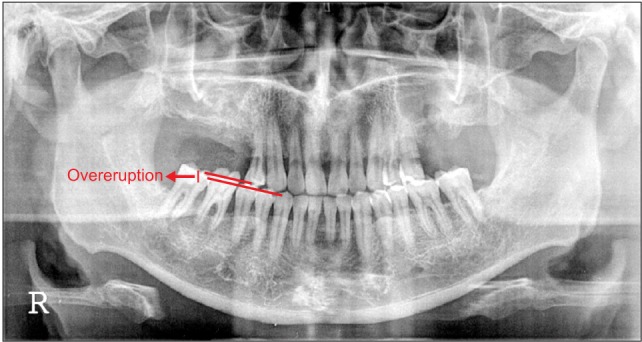J Korean Assoc Oral Maxillofac Surg.
2016 Jun;42(3):139-143. 10.5125/jkaoms.2016.42.3.139.
The clinical prognosis of implants that are placed against super-erupted opposing dentition
- Affiliations
-
- 1Department of Oral and Maxillofacial Surgery, Section of Dentistry, Seoul National University Bundang Hospital, Seongnam, Korea.
- 2Department of Dentistry and Dental Research Institute, School of Dentistry, Seoul National University, Seoul, Korea.
- 3Department of Prosthodontics, Section of Dentistry, Seoul National University Bundang Hospital, Seongnam, Korea.
- 4Department of Oral and Maxillofacial Surgery, School of Dentistry, Chosun University, Gwangju, Korea. sgckim@chosun.ac.kr
- KMID: 2309255
- DOI: http://doi.org/10.5125/jkaoms.2016.42.3.139
Abstract
OBJECTIVES
If teeth are missing, super-eruption of teeth in the opposing arch can occur in the area and can change the occlusal plane. When missing teeth are replaced with implants, the oral surgeon must determine whether or not the super-erupted teeth need to be treated in order to normalize the occlusal plane. In this study, we evaluated the clinical prognosis of dentition after implant placement and prosthetic treatment were completed in an occlusal plane altered by super-erupted teeth in the opposing arch without additional treatment of the super-erupted teeth.
MATERIALS AND METHODS
Twenty-two patients (9 males, 13 females) were treated with implants and prosthetics without addressing the super-erupted opposing dentition from April 2004 to August 2012 at Seoul National University Bundang Hospital. A total of 33 implants were placed. Values of crestal bone loss, survival rates, and surgical and prosthetic complications for an average of 29.6 months after prosthetic loading were recorded.
RESULTS
In one case, the cover screw was exposed after implant surgery. The mean crestal bone loss was 0.09±0.30 mm. Of the 33 implants, 31 survived, a survival rate of 93.94%. A prosthetic complication occurred in one case but functioned well after correction.
CONCLUSION
Favorable clinical results from prosthetic complications, crestal bone loss, and implant survival rates were exhibited in implants next to a super-erupted opposing tooth.
MeSH Terms
Figure
Reference
-
1. Craddock HL, Youngson CC, Manogue M, Blance A. Occlusal changes following posterior tooth loss in adults. Part 1: a study of clinical parameters associated with the extent and type of supra-eruption in unopposed posterior teeth. J Prosthodont. 2007; 16:485–494. PMID: 17559530.
Article2. Kiliaridis S, Lyka I, Friede H, Carlsson GE, Ahlqwist M. Vertical position, rotation, and tipping of molars without antagonists. Int J Prosthodont. 2000; 13:480–486. PMID: 11203673.3. Faggion CM Jr, Giannakopoulos NN, Listl S. How strong is the evidence for the need to restore posterior bounded edentulous spaces in adults? Grading the quality of evidence and the strength of recommendations. J Dent. 2011; 39:108–116. PMID: 21093527.
Article4. Creekmore TD, Eklund MK. The possibility of skeletal anchorage. J Clin Orthod. 1983; 17:266–269. PMID: 6574142.5. Kanomi R. Mini-implant for orthodontic anchorage. J Clin Orthod. 1997; 31:763–767. PMID: 9511584.6. Costa A, Raffainl M, Melsen B. Miniscrews as orthodontic anchorage: a preliminary report. Int J Adult Orthodon Orthognath Surg. 1998; 13:201–209. PMID: 9835819.7. Cohn-Stock G. Die chirurgische Immediatregulierung der Kiefer, speziell die chirurgische Behandlung der Prognathie. Vjschr Zahnheilk Berlin. 1921; 37:320.8. Wassmund M. Lehrbuch der praktischen chirurgie des Mundes und der kiefer: Band 1. Berlin: Leipzig Meusser;1935.9. Axhausen G. Über die korrigierende osteotomie am oberkiefer. Deutsch Z Chir. 1937; 248:515–522.
Article10. Schuchardt K. In bier, braun, and kummel: chirurgische operationslehre. Berlin: Leipzig Meusser;1935.11. Wunderer S. Swiss Society of Plastic and Reconstructive Surgeons. Surgical correction of the profile by operation on the maxilla. 1965. In : Proceedings: annual meeting Swiss Society of Plastic and Reconstructive Surgeons; Amsterdam: Excerpta Medica Foundation.12. Compagnon D, Woda A. Supraeruption of the unopposed maxillary first molar. J Prosthet Dent. 1991; 66:29–34. PMID: 1941670.
Article13. Proffit WR. Equilibrium theory revisited: factors influencing position of the teeth. Angle Orthod. 1978; 48:175–186. PMID: 280125.14. Gierie WV, Paterson RL, Proffit WR. Response of erupting human premolars to force application. Arch Oral Biol. 1999; 44:423–428. PMID: 10391500.
Article15. McArthur DR, Turvey TA. Maxillary segmental osteotomies for mandibular removable partial denture patients. J Prosthet Dent. 1979; 41:381–387. PMID: 370371.
Article
- Full Text Links
- Actions
-
Cited
- CITED
-
- Close
- Share
- Similar articles
-
- Total arch distalization with interproximal stripping in a patient with severe crowding
- Clinical evaluation of the removable partial dentures with implant fixed prostheses
- Implant-supported maxillary full-arch fixed prosthesis opposing mandibular natural dentition: A clinical report
- The second molars in orthodontics
- Retrospective study of the Implantium(R) implant with a SLA surface and internal connection with microthreads


